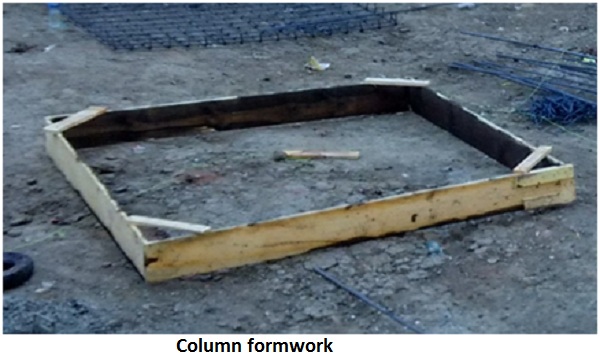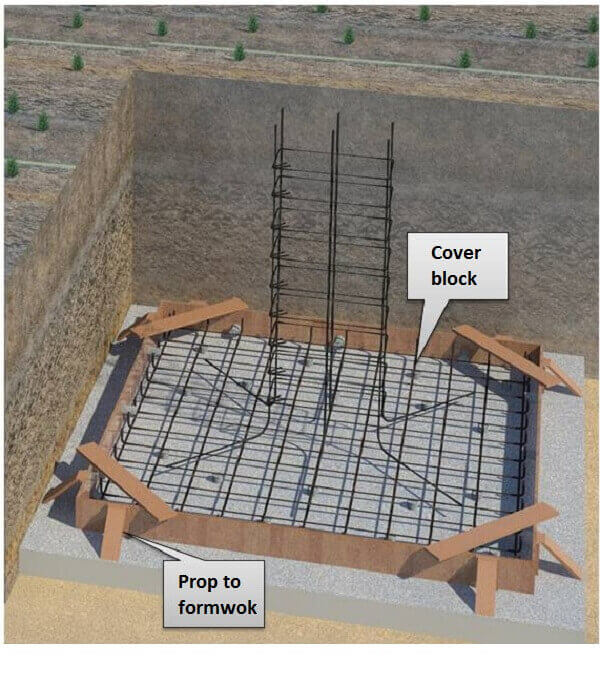General practice is to check when the footings are ready for concreting i.e. reinforcement is entirely tied up. However, the ideal practice would be to check it in two phase.
01. Check Formwork as well as soil strata
Before you allow placing of reinforcement, check the formwork and soil strata. It is necessary as certain formwork defects can’t be corrected or are difficult to correct after reinforcement is placed in position.
02. Checking Reinforcement
Check, whether the reinforcement has been placed as per size and spacing, given in the structural drawings. Hence as a standard engineering practice, one should check the formwork before reinforcement is placed or tied.
Points to Check Before Concreting Footings
01. Centering and shuttering/Formwork:
Even before commencing the shuttering & centering/formwork for footing , the following points need to be checked.

- Check the centre lines/margin from boundary etc. from reference column/bench mark pillar. check whether you are getting all statutory margins from the road and all rest boundary as per law and as drawing. Also, check orientation with respect to North.
- Ensure that the foundation is resting at a designed depth as per drawing.
- Size of formwork box should be as per drawing and it should be made up of approved materials.
- The formwork should be dry and shall be cleaned carefully before applying mould release agent. The same type of release agent should be used throughout on similar formwork materials.
- The surface of formwork should be even and thinly coated with mould release agent.
- The mould release agent should not come in contact with reinforcement or the hardened concrete as it will affect the bond between steel and concrete.
- The height of shuttering should be same as that of the height of pedestal and joint should be sealed to prevent any leakage of the cement slurry.
- Footing box should be supported properly so that position of footing box does not get changed during concreting.
- Centre of the footing should be marked with help of nail on planks or footing box.

- Shuttering for foundations should be sound in all seasoned condition i.e. dry, rainy or ground water is there
- Get approved the shuttering from Engineer-in-charge or supervisor before tying reinforcement.
- See that there is no earth collection on C.C. before tying reinforcement.
- If foundation depth is more, ensure that the excavated earth does not slide or fall till it is refilled. Do proper shoring and shuttering. Ensure proper ladder etc to go in the pit as well as for coming out. Also, ensure safety of labour’s working.
02. Reinforcement:


- The reinforcement steel should be free of any loose scale, rust, mud, or oil.
- Reinforcement of footing mesh (jali) should be cut as per bar bending schedule.
- Footing mesh should be prepared by tying the bars. Each and every, bar junction should be tied with binding wire of approved gauge.
- The bend (‘ L ‘) in mesh should be of 90° and bar is required to be upward.
- The center of the footing mesh should be matched with the center of the footing.
- Check the gauge of binding wire.
- Check lap length to be provided for lapping of steel reinforcement. However, for footing laps should not be allowed.
- Check that spacers are provided to achieve concrete cover. It should not be less than 50 mm.
- The minimum thickness of cover to main reinforcement should not be less than 50 mm for the surface in contact with earth face and not less than 40 mm for external exposed face.
- However, where the concrete is in direct contact with the soil, for example when P.C.C is not used at bottom of footing, it is usual to specify a cover of 75 mm. This allows for the uneven surface of the excavation.
- In case of raft foundation, whether resting directly on soil or on lean concrete, the cover for the reinforcement should not be less than 75 mm.
- The diameter of main reinforcing bars should be not less than 10 mm.
- The reinforcement steel grade, size, cover, spacing, and splicing should be as per the approved plan.
- When a column terminates into a footing or mesh, special confining reinforcement shall extend at least 300 mm into the footing or mesh or as per drawing.
- A minimum of four bars should be provided in column.
- A minimum three stirrups (rings) should be provided when column terminates into footing.
